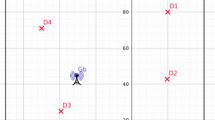Abstract
DLC protocols, scheduling, and multiplexing issues for broadband fixed wireless access networks based on ATM are discussed. The established DSA++ mac protocol has been developed at ComNets and has been widely applied within the German project ATMmobil. It has been a fundamental contribution to the etsi bran standardisation of HIPERLAN /2. The DSA++ is here modified to perform optimal within the fixed wireless access network environment. Therefore, realistic traffic as well as radio channel models for the respective scenarios are introduced. Simulation results are presented, showing the feasibility of the respective protocol stack for offering broadband multimedia services with reasonable quality of service. In addition to this advanced protocol approach, two systems are discussed which are currently under standardisation process. The IEEE 802.16 as well as the European hiperaccess systems are both proposed for fixed wireless access networks. Expected scenarios and applications are presented and basic requirements the standards have to fulfil are derived. As another aspect of access networks, their impact on the global information society is discussed.
Résumé
Cet article analyse les protocoles de liaison de données (data link control, dlc) ainsi que l’ordonnancement et le multiplexage dans les réseaux d’accès large bande sans fil basés sur atm. Le protocole mac dsa+ +, développé à ComNets et utilisé dans le projet allemand ATMmobil a été proposé à I’etsi pour la normalisation de hiperlan/2. On modifie ici dsa++ pour le rendre optimal dans un environnement de réseau d’accès fixe sans fil. Pour cela, on introduit dans les scénarios des modèles réalistes aussi bien pour le trafic que pour la partie radio. Les résultats de simulation ici présentés démontrent la faisabilité d’une telle pile de protocoles permettant de proposer des services multimédias à large bande avec une qualité de service raisonnable. On analyse également deux systèmes en cours de normalisation, l’ieee 802.16 et le système européen HIPERACCESS, tous deux destinés aux réseaux d’accès sans fil. On présente les scénarios et les applications attendus ainsi que les exigences minimales que devront satisfaire les futures normes. On évoque, enfin, l’impact des réseaux d’accès dans la société de l’information.
Similar content being viewed by others
References
Haine (J.), “hiperaccess: an access system for the information age”, inElectronics and Communication Eng. Journal, pp. 229-235, Oct. 1998.
Webb (W.), Introduction to Wireless Local Loop, Boston, London: Artech House Publishers, 1. ed., 1998.
Webb (W.), “A comparison of wireless local loop with competing access technologies”, inElectronics and Communication Eng. Journal, pp. 205-212, Oct. 1998.
Itu-r, Document ra97/plen/22, Wireless access terms and definitions, 1997.
Walke (B.), Petras (D.), Plassmann (D.), “Wireless ATM: Air Interface and Network Protocols of the Mobile Broad-band System,” inIEEE Personal Communications Magazine, 3, pp. 50–56, Aug. 1996.
Petras (D.), Vornefeld (U.), “Joint Performance of DSA++ mac Protocol and sr/d-arq Protocol for wireless ATM under realistic traffic and channel models”, in1st International Workshop on Wireless Mobile ATM Implementation (wmATM’98), (Hangzhou, China), Apr. 1998.
Petras (D.), Hettich (A.), “Performance Evaluation of a Logical Link Control Protocol for an ATM Air Interface”, inInt. Journal of Wireless Information Networks, vol. 4, no. 4,1997.
Petras (D.), Crumbling (A.), “Wireless atm: Performance Evaluation of a DSA++ mac Protocol with Fast Collision Resolution by a Probing Algorithm,” inInt. Journal of Wireless Information Networks,4, no. 4,1997.
Walke, (B.), Mobile Radio Networks, Chichester, Sussex, U.K.: Wiley & Sons Ltd., 1. ed., 1999.
Forkel (I.), Mangold (S.), “Computer Simulation of Performance Enhancing Methods in ATM based Fixed Wireless Access Networks,” inspects 2000, Vancouver, B.C., Canada, Jul. 2000
Forkel (I.), KrÄmling (A.), Bernhardt (D.), “On Allocation and Adaptive Transmission Technology in atm based Fixed Wireless Access Networks” submitted toepmcc 2001, Vienna, Austria, Feb. 2001
Mangold (S.), Siebert (M.), Kiesel (C.), “Fair coexistence of DECT and phs working in the same Frequency Band in Fixed Wireless Access Networks,” inpimrc ’99, (Osaka, Japan), Sep.1999.
Petras (D.), “Air Interface of an ATM Radio Access Network”,in IFIP Broadband Communications ’98, Stuttgart, Germany, Apr. 1998.
ETSI BRAN, “High PErformance Radio Local Area Network (Hiperlan), Requirements and Architectures for Wireless ATM Access and Interconnection,” TR 101 031, ETSI, Apr. 1997.
Bertsekas (D.), Gallager (R.) Data Networks, Englewood Cliffs, NJ, Prentice-Hall, 1987.
Karthaus (U.), Noè (R.), “Influence of polarisation on 30GHz broadband radio channels,” inIntern. Zurich Seminar on Broadband Communication, (Zurich), Feb. 17-19 1998.
Andersen (J.B.), Rappaport (T.S.), Yoshida, (S.), “Propagation measurements and models for wireless communication channels”,IEEE Communications Magazine,44, pp. 163–171, Jan. 1995.
Karthaus (U.), Noè (R.), GrÄser (A.), “High resolution channel impulse response measurements for radio in the local loop,” inacts Mobile Communications Summit, Aalborg, Oct. 7-10 1997.
Davic, “Davic 1.1 specification part 8”, tech. rep., davic (Digital Audio-Visual Council), Geneva (Switzerland), available at ftp://ftp.davic.org/Davic/Pub/Specl_1/prtOS ll.doc, 1999.
Fritchman (B.D.), “A binary channel characterization using partitioned markov chains,”IEEE Transactions on Information Theory, vol. 13, pp. 221–227, Apr. 1967.
Mangold (S.), Lott (M.), Evans (D.), Fifield (R.), “Indoor Radio Channel Modeling - Bridging from Propagation Details to Simulation,” in pimrc ’98, (Boston, Massachusetts), pp. 625-629, ieee, Sep. 1998.
Mangold (S.), Lott (M.), Evans (D.), Fifield (R.) et. al., “A simple/accurate Propagation Model for the 5.2 GHz Indoor Radio Channel,”etsi ep bran. Temporary Document wg3td73, 1997.
Gilbert (E.N.), “Capacity of a Burst-Noise Channel”, inBell System Technical Journal,39, pp. 1253–1265, Mar. 1960.
Papazian (P.B.), Hufford (G.A.), Achatz (R.J.), Hoffman (R.), “Study of the local multipoint distribution service radio channel, ” inieee Transactions on Broadcasting,43, pp. 175–184, June 1997.
Author information
Authors and Affiliations
Corresponding author
Rights and permissions
About this article
Cite this article
Mangold, S., Forkel, I. Optimal DLC protocol configuration for realistic broadband fixed wireless access networks based on ATM. Ann. Télécommun. 55, 567–576 (2000). https://doi.org/10.1007/BF02999828
Received:
Accepted:
Issue Date:
DOI: https://doi.org/10.1007/BF02999828
Key words
- Telecommunication network
- Transmission protocol
- Data link layer
- ATM
- Radio access
- Broadband
- Radio channel
- Simulation
- Standardization




